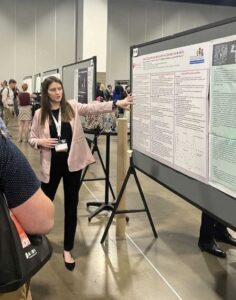The 49th annual Applied Behavior Analysis International (ABAI) conference was filled with presentations, posters, and discussions from the CSH-RUCARES staff in both the Severe Behavior Program and the Pediatric Feeding Disorders Intensive Program.
Check out all the interesting research projects that were shared during the conference from the Severe Behavior team:
Dr. Brian Greer, BCBA-D – Discussant: Dr. Brian Greer served as the discussant for the symposium titled, “Adaptations of Functional Communication Training with Multiple Schedules”.
Dr. Daniel Mitteer, BCBA-D – Discussant: Dr. Daniel Mitteer served as the discussant for the symposium titled, “A Look at Functional Communication Training: Persistence, Schedule Thinning, and Without Extinction”.

Dr. Casey Irwin-Helvey, BCBA-D: Symposium presenter: Casey participated in the symposium titled, “Basic and Applied Investigations of Resurgence”. In this presentation titled, “Resurgence of Destructive Behavior Following Reductions in Alternative Reinforcement: A Prospective Analysis”, we conducted a prospective analysis of resurgence of destructive behavior following a fixed progression of schedule thinning steps (Study 1) and a pseudo-random order of schedule thinning steps counterbalanced across participants (Study 2).
Shannon Angley, BCBA: Symposium presenter: Shannon presented in the symposium titled, “Adaptations of Functional Communication Training with Multiple Schedules”. Much of Mult-FCT research has involved (a) rapid alternations between reinforcement and extinction components and (b) the use of physical discriminative stimuli like index cards or poster boards. The current symposium describes adaptations of this arrangement. Angley et al. assessed embedding discriminative stimuli directly into a communication device (e.g., coloring the communication icons themselves) with an adult with autism.
Poster- Incorporating Components of Brief Habit Reversal to Reduce Skin Picking and Vocal Tics in an Adult With Autism: The purpose of the current study was to evaluate the efficacy of two main components of habit reversal (i.e., modified awareness training [i.e., self-monitoring] and competing-response training) in reducing the vocal tics and skin picking exhibited by a young adult with IDD.

Jessica French, BCBA: Symposium presenter: Jessica presenter on the study, “Recent Translational Investigations Examining Resurgence-Mitigation Strategies”. The present study corrected the limitation identified in Greer et al. 2020, by (a) employing a sequential design to decrease the possibility of multiple-treatment interference, (b) evaluating more treatment durations, (c) arranging treatments of fixed durations, and (d) conducting treatments of more extreme duration in a different clinical sample.
Halle Norris, BCBA: Symposium presenter: Halle participated in the symposium titled, “Evaluating Sensitivity to Consequences in Children With Autism Spectrum Disorder (ASD)”; The purpose of the present study was to explore this possibility while also assessing the generality of the results reported by Briggs et al. (2018) by implementing guided and free-choice trials in which participants chose between two multiple-schedule arrangements, each of which programmed signaled periods of isolated reinforcer availability and unavailability.
Poster: Basic and Applied Research on Extinction Bursts: This poster highlighted a study that was recently published in 2023 by Fisher et al. In this paper, we first review the basic and applied literature on the extinction burst. We then describe a recent refinement of the concatenated matching law called the temporally weighted matching law that appears to resolve the above-mentioned issues regarding the extinction burst. We present illustrative translational data based conceptually on the model. Finally, we discuss specific recommendations derived from the temporally weighted matching law regarding procedures clinicians could implement to potentially mitigate or prevent extinction bursts.

Liam McCabe, BCBA: Symposium presenter: Liam participated in the symposium titled, “Advances in the Analysis of Behavior-Physiology Relations” with the study, “Heart Rate as a Predictive Biomarker for Severe Destructive Behavior”. The purpose of this study was to examine the predictive validity of HR on varying topographies and functions of destructive behavior while controlling antecedent and consequent events through functional analyses (FA).
Poster- Funding Trends in the Journal of Applied Behavior Analysis (1968–2021)- Previous research has demonstrated that funding (e.g., a federal grant) is correlated with a myriad of benefits including probability of publication, higher citation rates, and increased probability of promotion. To date, no study has examined the prevalence of funded articles and associated outcomes in the Journal of Applied Behavior Analysis (JABA). We examined every JABA publication from 1968 to 2021 to determine whether funding was disclosed and, if so, the funding source and article type.
